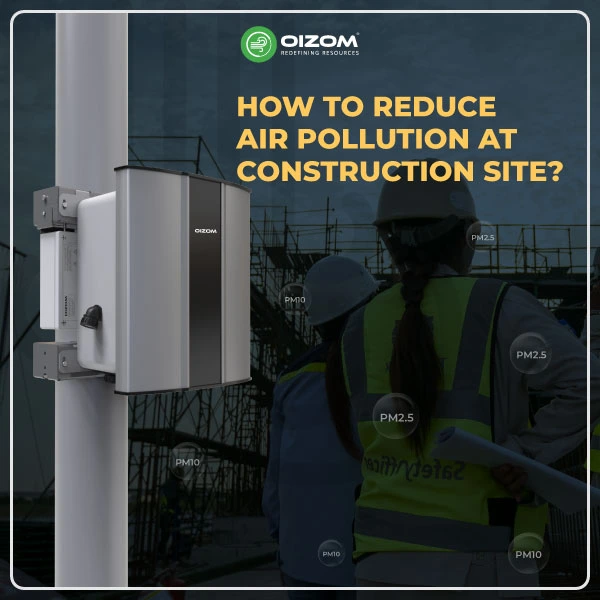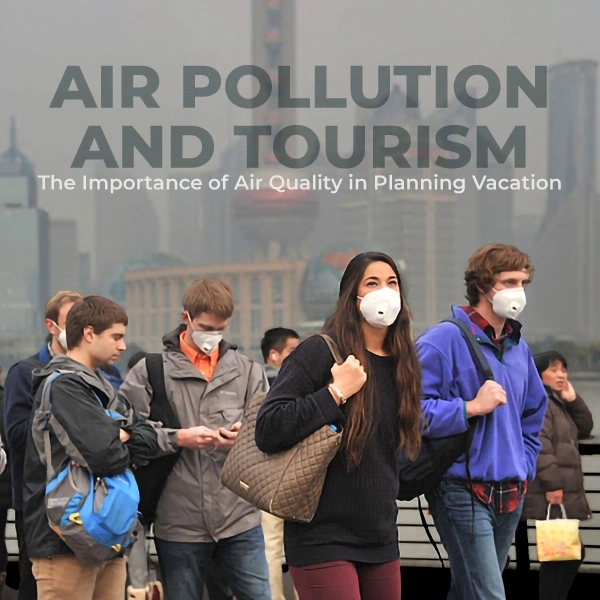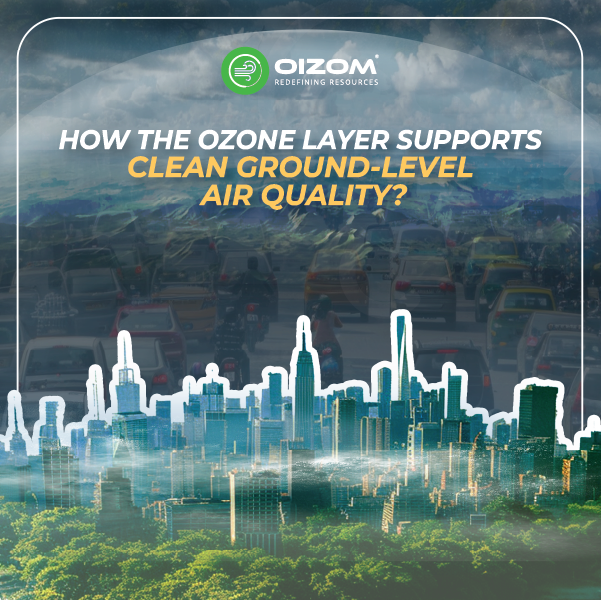Summary
Construction is one of the fastest-growing sectors globally and in India, vital for economic development, while adding a heavy burden on the environment. It considerably contributes to air, water, noise, and solid waste pollution, accounting for nearly 39% of global carbon emissions. In Delhi, construction dust alone may be responsible for up to 30% of air pollution.
Houses build dreams, but what’s often unseen is the environmental cost behind their creation. Today, constructing a modest 100 m² home in India consumes around 850-1050GJ of energy, equivalent to burning 29,000–35,800 kg of coal, and releases carbon emissions so high, it would take over 3,000 mature trees a year to absorb them.
As the sector rapidly expands, so do its air pollution impacts, from land clearing and diesel exhaust to hazardous materials and uncovered waste. These activities release PM₁₀, PM₂.₅, NOₓ, VOCs, and toxic gases that degrade air quality and endanger public health. Addressing this requires a shift toward cleaner machines, smarter site planning, better dust and material control, and real-time air quality monitoring. It is equally important to train site workers and enforce protocols consistently. Together, these actions can help reduce emissions, protect people’s health, and make construction more sustainable in the long run.
Introduction
In the past years, India’s urban skyline has been reshaped rapidly, with high-rise buildings, expanding infrastructure, and large-scale housing projects (due to programs such as Pradhan Mantri Awas Yojana (PMAY), reshaping cities and towns across the country. The construction sector in India, now valued at over $1 trillion, plays a vital role in economic growth, with approximately 100 million new homes needed in the coming decade to meet demand.
However, behind this drive lies an urgent issue that often remains unresolved: air pollution generated at construction sites. Dust from excavation, emissions from heavy equipment & vehicles, and improper handling of materials contribute significantly to air pollution, affecting both workers and residents in surrounding areas. While construction is also linked to noise, water, and solid waste pollution, air pollution is felt the closest, especially in urban environments.
Between 2023 and 2024, construction activities in Delhi were halted for a total of 78 days under the Graded Response Action Plan (GRAP) as an emergency measure to curb rising air pollution. Although such interventions are well-intentioned, they leave daily wage workers unpaid and repeatedly delay projects. Moreover, the scientific evidence to confirm the ban’s result on air quality remains limited.
Although environmental regulations exist, they often struggle on the ground level due to a lack of awareness, weak enforcement, or insufficient on-site practices. Which brings us to a critical question: which pollutants are released during construction, what are their impacts, and how can we effectively manage or reduce them?
This blog explores those answers, focusing on practical, actionable strategies to curb air pollution at construction sites because true progress must be both visible and breathable.
What Causes Air Pollution at Construction Sites?
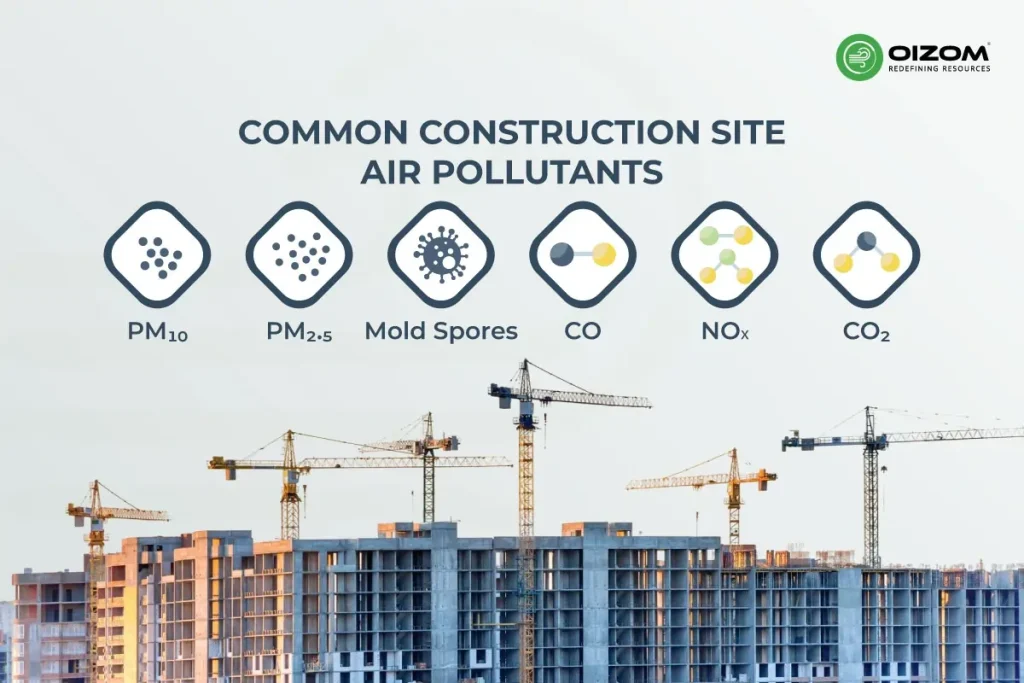
1. Land Clearing & Earthmoving
Key Pollutants: PM₁₀, PM₂.₅, Fugitive Dust
- Activities such as digging, excavation, grading, and levelling generate large amounts of particulate matter.
- Fugitive or airborne dust can linger in the air for days and spread to nearby roads and neighborhoods.
2. Diesel Engine Exhaust
Key Pollutants: PM₂.₅, Nitrogen Oxides (NOₓ), Carbon Monoxide (CO), Carbon Dioxide (CO₂), Hydrocarbons
- Emissions resulting from diesel-powered vehicles, machinery, and generators commonly used on construction sites. These pollutants contribute to poor air quality and greenhouse gas accumulation.
3. Construction & Demolition (C&D) Dust
Key Pollutants: Particulate Matter, Asbestos Fibers, Lead Particles, Mold Spores, Biological Contaminants (e.g., bird waste)
- Demolishing older structures can release hazardous materials like asbestos and lead.
- Activities like cutting, drilling, and grinding release fine particulate matter, which can be carried away by wind, creating regional air quality issues.
- Mold spores and biological contaminants like bird waste are released when damp/ moist, decaying, or infested building materials are disturbed during demolition.
4. Open Waste Burning
Key Pollutants: Toxic Gases (e.g., dioxins, furans), VOCs, Smoke and Soot (PM), Carbon Monoxide (CO)
Burning plastic, chemically treated wood, packaging, and other construction debris releases highly toxic pollutants into the air. Addressing this challenge requires advanced measures like real-time air quality monitoring at open waste burning sites, which provides actionable data to curb harmful emissions and safeguard public health.
5. Use of Hazardous Construction Materials
Key Pollutants: Volatile Organic Compounds (VOCs), Ozone Precursors, Indoor/Outdoor Air Toxics
- Emitted from paints, thinners, adhesives, roofing materials, chemically treated wood, and chemical cleaners.
- VOCs contribute to ground-level ozone and pose long-term health risks.
6. Construction & Demolition Waste (C&D Waste)
Key Pollutants: Dust (PM), Emissions from Decomposing or Exposed Materials, Secondary VOC Emissions
- Waste materials like rubble, concrete, wood, and metal can release pollutants during handling and storage.
- Exposed waste piles act as secondary pollution hotspots through wind or weather exposure.
7. On-Site Traffic and Transportation
Key Pollutants: Resuspended Dust (PM), Exhaust Emissions (NOₓ, CO, PM, VOCs)
- Continuous movement of trucks, cement mixers, and heavy transport vehicles resuspends settled dust.
- Additional emissions come from idle vehicles, poorly maintained equipment, and unpaved surfaces.
Impact of Construction Pollution
1. Environmental Impact
- Air, Noise & Water Pollution: Construction releases dust, diesel exhaust, and noise, polluting the air, disturbing nearby communities, and contaminating water bodies and soil through runoff.
- Resource Consumption & Waste: High demand for energy, sand, and water, added to improper handling of construction waste, worsens pollution.
2. Social Impact
- Worker & Community Exposure: Labourers and nearby residents are exposed to harmful dust and fumes daily, leading to respiratory and other health issues.
- Public Nuisance: Constant noise, dust settling on homes, and blocked roads cause daily life disruptions for citizens.
3. Economic Impact
- Delays & Productivity Loss: Pollution-related bans (like in Delhi) halt work, delay timelines, and result in income loss for workers and financial strain for contractors.
- Cost Burden: Health impacts and project delays lead to increased costs, often pushed onto buyers or the public.
4. Regulatory Impact
- Compliance Gaps: Though rules exist, lack of awareness and poor enforcement lead to frequent violations at construction sites.
- Monitoring Issues: Unclear guidelines on how to monitor and act on air quality data limit the effectiveness of current regulations.
Strategies to Reduce Air Pollution at Construction Sites
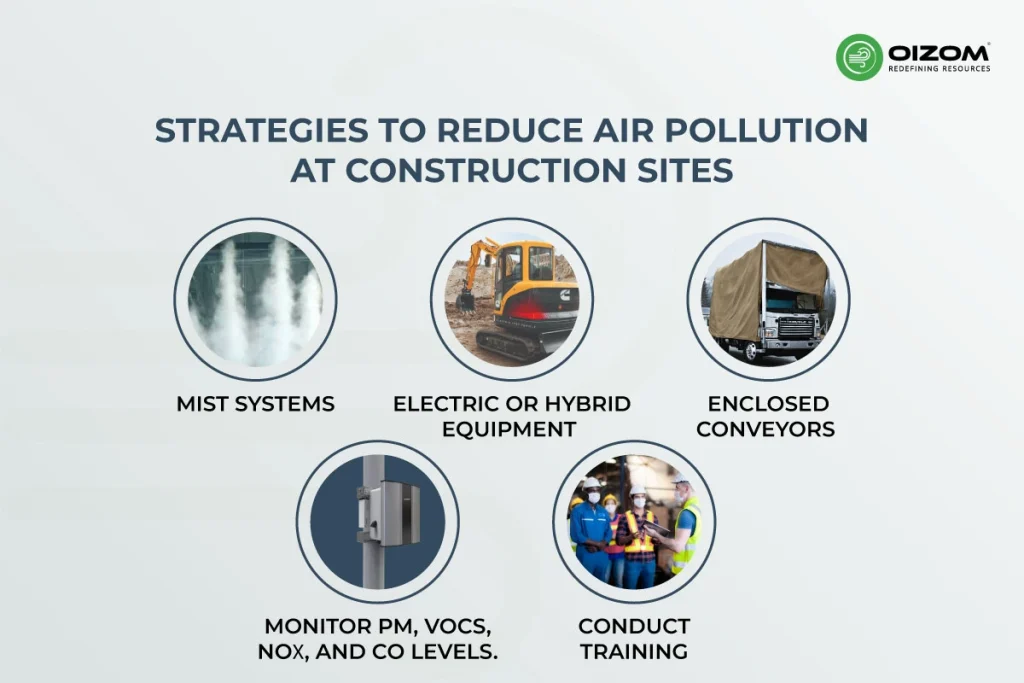
1. Control Dust from the Ground Up
Controlling Dust from the Ground Up” refers to stopping dust from spreading by managing it right at the ground level, where it starts. In construction sites, dust is created from digging, moving soil, and transporting materials. If left unnoticed, this dust can pollute the air, harm workers’ health, and affect nearby residents and businesses. This strategy primarily focuses on preventing dust from rising in the first place, this is done by keeping the soil stable, using water or barriers, and minimizing soil disturbance. This will simply help to reduce PM₁₀ and PM₂.₅ emissions.
Key Steps:
- Stabilize exposed soil with water, chemical binders, or vegetative cover.
- Improve road surface specially at haul roads and high-traffic zones.
- Install fences, nets, or tree lines to slow down wind speed.
- Use mist systems or sprinklers near dusty operations.
Example:
Applying gravel to access roads will limit dust kick-up from vehicle movement.
and using misting will trap airborne dust near crushers and bring it down.
2. Use Eco-Friendly Construction Machinery
This simply means using machines and equipment that create less air pollution while working on construction sites. Traditional construction machines often run on diesel, which releases harmful smoke and gases into the air. This not only pollutes the environment but also affects the health of workers and people nearby. Switching to electric or hybrid machines, using cleaner fuels, or simply keeping old machines well-maintained can lead to a reduction in the amount of harmful exhaust released. This approach makes the air cleaner and the construction process more sustainable.
Key Steps:
- Adopt electric or hybrid equipment where practically possible.
- Use biodiesel or ultra-low sulfur diesel (ULSD).
- Modify old equipment with DPFs or catalytic converters to reduce harmful emissions.
- Conduct regular engine maintenance.
- Limit idle vehicles.
Example:
Replacing diesel cranes with electric ones and enforcing idle limits drastically reduces emissions.
3. Optimize Material Handling and Storage
Optimize Material Handling and Storage” refers to managing construction materials that are stored, moved, and used in a way that reduces air pollution. Construction materials such as sand, cement, and gravel can create a lot of dust if not handled carefully. If these materials are left uncovered or released from heights, dust spreads in the air. This strategy focuses on covering, handling, and using proper storage methods for materials.
Key Steps:
- Cover or enclose sand, gravel, and cement piles.
- Reduce material drop heights while transferring.
- Use enclosed conveyors instead of open transport.
- Lightly wet dusty materials before handling.
- Store VOC-emitting materials in sealed containers.
Example:
Covering gravel piles with tarpaulin (a strong sheet) prevents wind from blowing dust into the air.
4. Set Up Air Quality Monitoring On-Site
Installing air quality monitoring devices at the construction site helps maintain regular checks on the air quality. It monitors pollutants like dust, smoke, and harmful gases that may be released during construction work. Measuring these pollution levels in real time helps inform the workers and site managers to respond quickly if the air becomes too polluted (like increasing dust control or reducing machinery use). This helps protect the health of workers, comply with regulations, and take proactive steps.
Key Steps:
- Install sensors near excavation or machinery zones.
- Monitor PM, VOCs, NOₓ, and CO levels.
- Use alert thresholds to trigger mitigation steps.
- Analyze trends to fine-tune pollution controls.
- Maintain logs to support compliance audits.
Example:
Oizom’s air quality monitors like Dustroid and Polludrone use sensor technology to give alerts when PM₁₀ and PM₂.₅ levels rise, helping sites increase misting during demolition to control dust effectively.
5. Train Workers and Supervisors
Many times, pollution occurs because people are unaware of the right methods to control dust or handle materials safely. This strategy ensures that workers understand how to use the equipment correctly, follow safety rules, and respond to air quality alerts. Supervisors are trained to monitor these activities and make sure that the rules are followed. When everyone on site is well-informed, pollution control becomes more effective and consistent.
Key Steps:
- Conduct training on dust suppression and emissions control.
- Familiarize teams with safety regulations protocols.
- Teach correct use of low-dust tools and PPE.
- Assign supervisors to enforce air quality protocols.
- Conduct training regularly as standards keep evolving.
Example:
Weekly sessions on using mist cannons and low-emission tools foster daily compliance.
6. Plan Site Layout for Better Airflow
This points to designing the construction site in a way that allows air to move freely and carry away dust and pollutants, instead of letting them build up in one place. This involves carefully choosing where activities like digging, material storage, or heavy machinery will take place. This needs to consider the wind direction and consider how much pollution spreads to workers or nearby areas. Adding open spaces, natural barriers like trees, can also help trap or deflect dust. This strategy uses smart planning to make the air cleaner and the site healthier for everyone.
Key Steps:
- Position dust-heavy operations away from residential areas.
- Use wind direction analysis to plan dust-heavy activities.
- Introduce green belts or buffer zones with vegetation.
- Design efficient vehicle paths with treated or paved roads.
- Install ventilation systems for enclosed workspaces.
Example:
Putting concrete mixers downwind (direction the wind is blowing toward) and planting trees at site edges helps stop dust from blowing into nearby areas.
Conclusion
Construction and infrastructure development are key to economic progress, however, progress shouldn’t come at the cost of breathable air. As this blog explored, construction activities contribute largely to air pollution, especially in cities where dust, vehicle exhaust, and poor material handling can severely impact air quality. Beyond environmental impact, the health effects of poor air quality in construction are a growing concern, affecting workers and nearby communities alike. While temporary bans and basic regulations exist, lasting solutions come from smarter site practices, informed planning, and continuous monitoring.
Recognizing the effects of cement and concrete manufacturing on air quality is a key part of this effort, as these materials are central to construction and contribute substantially to emissions if not managed properly. This is where Oizom’s instruments have emerged as powerful tools, helping the construction industry monitor, manage, and minimize air pollution at the source. Whether it’s Dustroid for precise particulate tracking, Polludrone for multiparameter monitoring, or the Envizom platform for real-time analysis and automation, Oizom solutions equip developers with the understanding needed to take proactive and timely action. A recent case study on our website highlights how these tools were successfully implemented to bring down dust levels on a major construction site.
Cleaner construction isn’t just possible, it’s necessary. With smart technologies and the right strategies in place, we can ensure that cleaner air and growing skylines can coexist.

